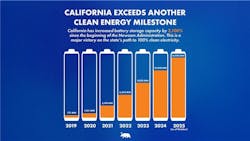California Reaches 16,942 MW of Battery Storage Available
At the UN Climate Change Conference in Brazil, Governor of California, Gavin Newsom has announced that California has reached 16,942 MW of battery storage available.
The new total marks an increase of about 1,200 MW in the past six months and a 2,100% surge in storage capacity since Governor Newsom took office in 2019. California has built one-third of the storage capacity estimated to be required by 2045 to reach its clean energy goals.
Governor Newsom also announced that California is joining the Global Energy Storage and Grids Pledge, a COP initiative supported by more than 100 countries and organizations. The pledge aims to deploy 1,500 GW of energy storage, double worldwide grid investments, and build 25 million kms of new transmission infrastructure by 2030, essential actions to deliver on the tripling of renewables agreed to at COP28.
Of California’s total energy storage capacity, 13,880 MW is from large utility-scale projects, while the remaining is from behind-the-meter battery systems installed on more than 200,000 homes (2,213 MW) and businesses, schools and local government facilities (849 MW). The smaller systems account for a resource that helps reduce demand during high-use periods, providing new ways to keep the grid balanced in real time.
California has more installed battery capacity than every other jurisdiction on the planet with the exception of China. Within the United States, California leads all states on installed storage capacity, followed by Texas with roughly 9,000 MW.
Clean energy is the cheapest source of electricity generation globally and the cost of battery storage has fallen by 93% since 2010.
“The state is setting the standard for deploying storage resources to complement a grid increasingly powered by renewable energy, “said California Public Utilities Commission (CPUC) President Alice Reynolds. “It’s a smart way to manage electricity costs while reducing greenhouse gas emissions and adapting to climate change.”
The state has not issued a Flex Alert, an emergency call for public electricity conservation, since 2022. Battery storage has allowed the grid to sustain the record heat and extreme weather without outages. The summer of 2024 was California’s hottest on record, according to the National Oceanic and Atmospheric Administration, and even though the grid stood strong with zero flex alerts issued.
Battery systems provide enough capacity to meet the equivalent of roughly one-quarter of California’s record peak demand for several hours.
In September 2024, Governor Newsom created a cross-agency collaborative to improve safety as technology continues evolving. Key initiatives included an update to the California Fire Code expected in 2025, which will involve enhanced BESS safety standards.
The (CPUC) voted in March to require new safety protocols for the maintenance and operation of BESS facilities. The Governor has signed Senate Bill 283, which will require battery storage developers to engage with local fire authorities to address facility design, assess risks, and integrate emergency response plans.
Renewable energy supplies nearly 67% of in-state retail electricity sales, and California continues to retire fossil-fuel plants and will eliminate coal power from its electricity mix by the end of 2025. The California Independent System Operator has, on average, met demand with 100% clean energy for nearly six hours every day so far in 2025.
